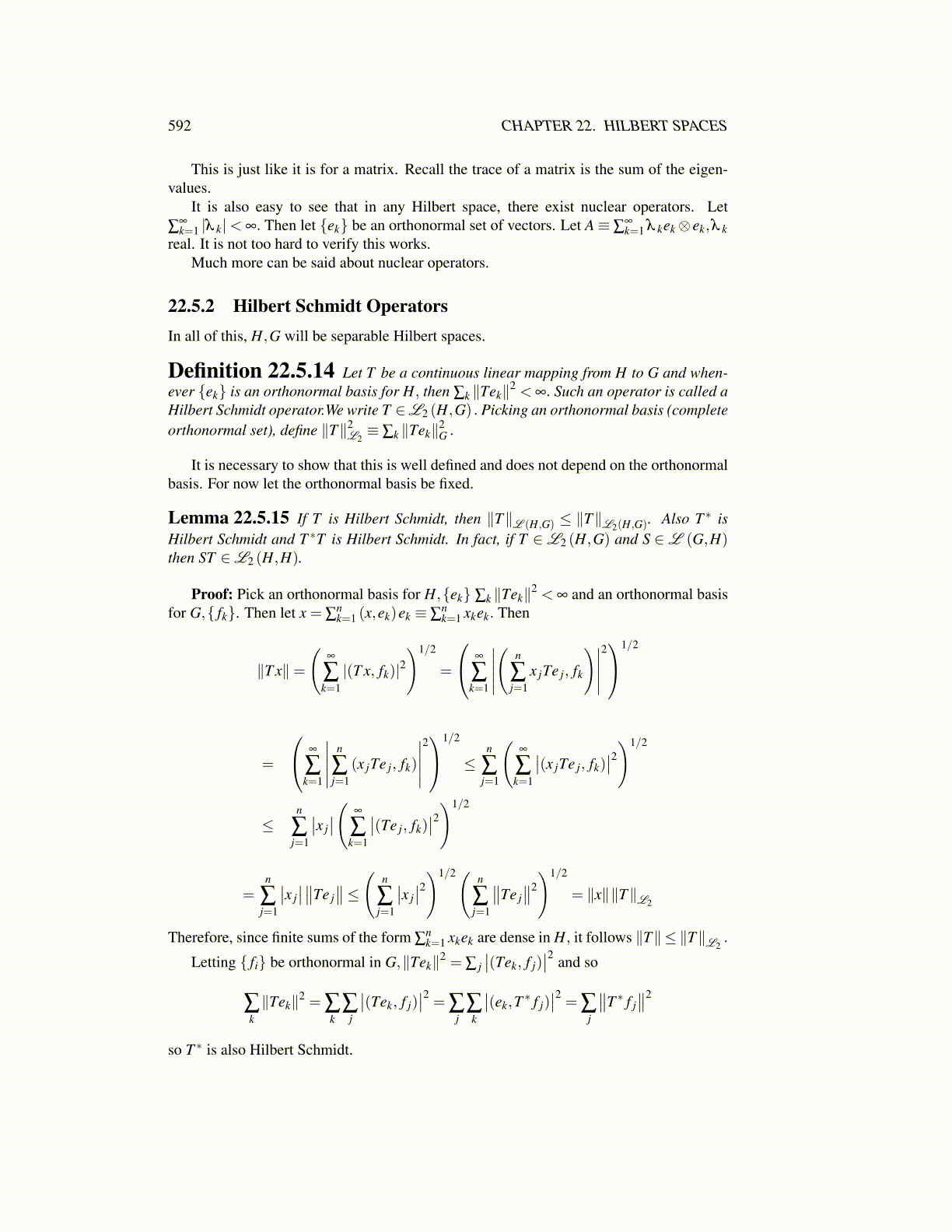
592 CHAPTER 22. HILBERT SPACES
This is just like it is for a matrix. Recall the trace of a matrix is the sum of the eigen-values.
It is also easy to see that in any Hilbert space, there exist nuclear operators. Let∑
∞k=1 |λ k|< ∞. Then let {ek} be an orthonormal set of vectors. Let A≡ ∑
∞k=1 λ kek⊗ ek,λ k
real. It is not too hard to verify this works.Much more can be said about nuclear operators.
22.5.2 Hilbert Schmidt OperatorsIn all of this, H,G will be separable Hilbert spaces.
Definition 22.5.14 Let T be a continuous linear mapping from H to G and when-ever {ek} is an orthonormal basis for H, then ∑k ∥Tek∥2 < ∞. Such an operator is called aHilbert Schmidt operator.We write T ∈L2 (H,G) . Picking an orthonormal basis (completeorthonormal set), define ∥T∥2
L2≡ ∑k ∥Tek∥2
G .
It is necessary to show that this is well defined and does not depend on the orthonormalbasis. For now let the orthonormal basis be fixed.
Lemma 22.5.15 If T is Hilbert Schmidt, then ∥T∥L (H,G) ≤ ∥T∥L2(H,G). Also T ∗ isHilbert Schmidt and T ∗T is Hilbert Schmidt. In fact, if T ∈L2 (H,G) and S ∈L (G,H)then ST ∈L2 (H,H).
Proof: Pick an orthonormal basis for H,{ek} ∑k ∥Tek∥2 < ∞ and an orthonormal basisfor G,{ fk}. Then let x = ∑
nk=1 (x,ek)ek ≡ ∑
nk=1 xkek. Then
∥T x∥=
(∞
∑k=1|(T x, fk)|2
)1/2
=
∞
∑k=1
∣∣∣∣∣(
n
∑j=1
x jTe j, fk
)∣∣∣∣∣21/2
=
∞
∑k=1
∣∣∣∣∣ n
∑j=1
(x jTe j, fk)
∣∣∣∣∣21/2
≤n
∑j=1
(∞
∑k=1
∣∣(x jTe j, fk)∣∣2)1/2
≤n
∑j=1
∣∣x j∣∣( ∞
∑k=1
∣∣(Te j, fk)∣∣2)1/2
=n
∑j=1
∣∣x j∣∣∥∥Te j
∥∥≤( n
∑j=1
∣∣x j∣∣2)1/2( n
∑j=1
∥∥Te j∥∥2
)1/2
= ∥x∥∥T∥L2
Therefore, since finite sums of the form ∑nk=1 xkek are dense in H, it follows ∥T∥ ≤ ∥T∥L2
.
Letting { fi} be orthonormal in G,∥Tek∥2 = ∑ j∣∣(Tek, f j)
∣∣2 and so
∑k∥Tek∥2 = ∑
k∑
j
∣∣(Tek, f j)∣∣2 = ∑
j∑k
∣∣(ek,T ∗ f j)∣∣2 = ∑
j
∥∥T ∗ f j∥∥2
so T ∗ is also Hilbert Schmidt.